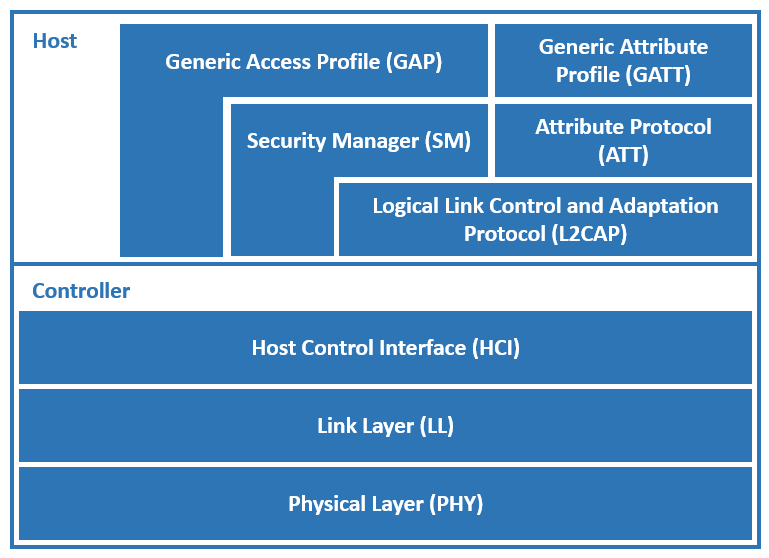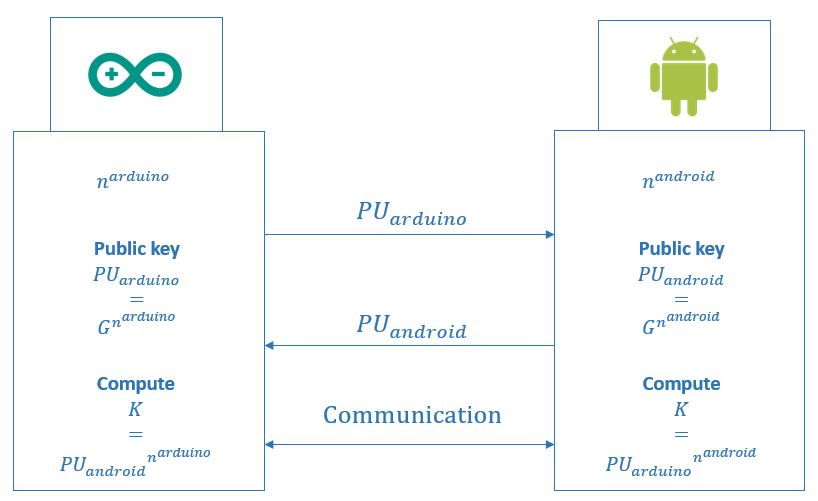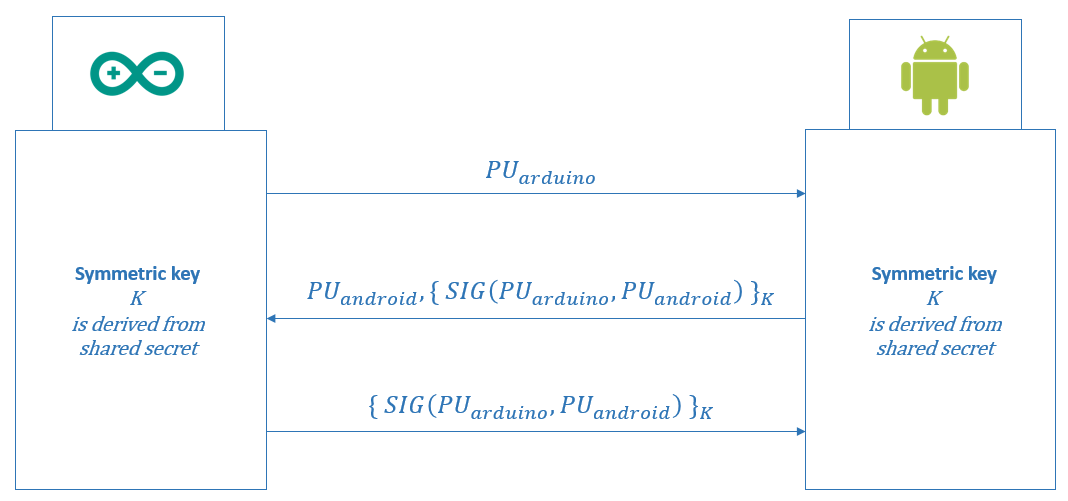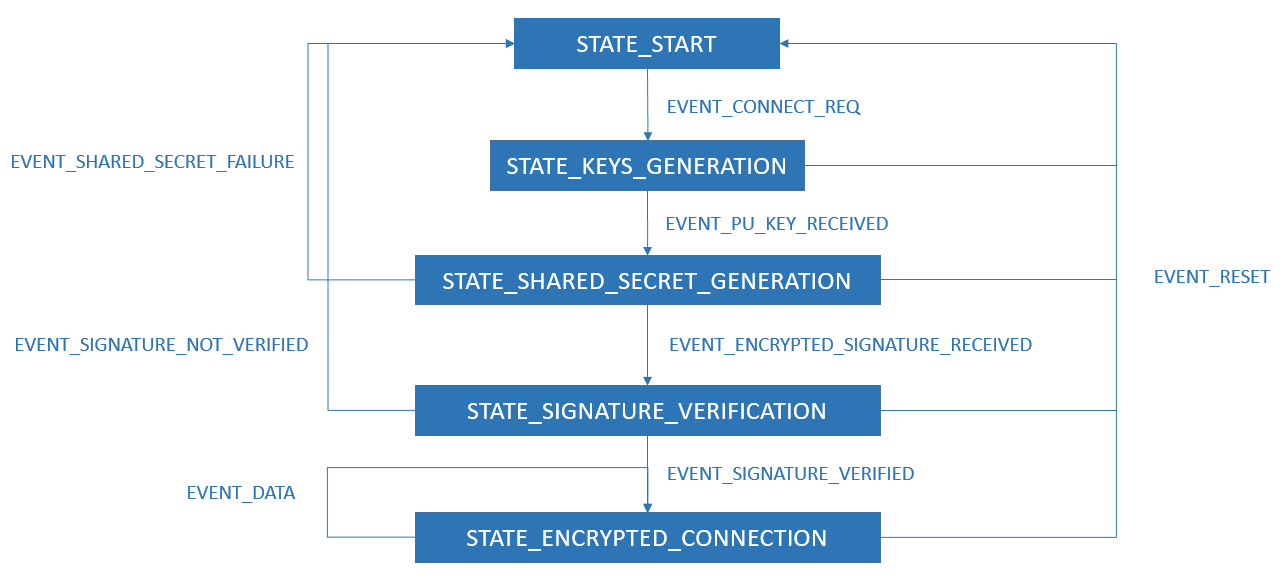Secure communication between Arduino Uno microcontroller and Android application over BLE (Bluetooth Low Energy). Establishment of secure communication is done by using Elliptic-Curve Diffie-Hellman key exchange protocol in order to cover privacy aspect and Station to Station protocol in order to cover authentication aspect.
- Bluetooth Low Energy (BLE)
- ECDH key exchange protocol
- STS protocol
- State Machine
- Messages
- Arduino
- Performances
- Support
BLE or Bluetooth Low Energy is a wireless personal area network technology.
GAP is the layer of the BLE stack which determines the network topology of the BLE system. Based on this layer, there are two roles in the BLE communication: BLE GAP Central and BLE GAP Peripheral.
The GAP Central is typically the device which initiates the connection with the GAP Peripheral. Once the two devices are connected, they will perform a “pairing” process where they will exchange the information necessary to establish an encrypted connection.
GATT is the layer of the BLE stack used by the application for data communication between two connected devices. Data is passed and stored in the form of characteristics which are stored in memory of BLE device. When two devices are connected, they obtain one of two roles: GATT Server and GATT Client.
The GATT Server is the device containing the characteristic database that is being read or written by a GATT Client. Consider characteristics as groups of information called attributes.
A typical characteristic is composed of the following attributes:
- Characteristic Value
- Characteristic Declaration
- Client Characteristic Configuration
- Characteristic User Description
Max number of bytes that is possible to transfer over GATT layer at once is 20–23. Real number depends on how long GATT specific messages are.
Refer to this article about GATT layer of the BLE protocol stack.
- > 100m range
- 1 Mbit/s over the air data rate
- not specified number of active slaves
- 6ms latency
Pairing is the process by which two BLE devices exchange device information so that secure link can be established. The process varies somewhat between the BLE 4.2 devices and the older 4.1 and 4.0 devices.
In BLE 4.2, devices use ECDH key exchange in their pairing process. The only problem with ECDH key exchange is that it does not give the user a way to verify the authenticity of the connection. Therefore, it is still vulnerable to MITM attacks.
- passive eavesdropping
- MITM attacks
- identity tracking
Refer to this article about BLE security.
- Arduino Uno board as a user A selects its private key PRarduino, an integer less than the order n, and generates public key PUarduino which belongs to a point on elliptic curve
- Android app as a user B selects its private key PRandroid, an integer less than the order n, and generates public key PUandroid which belongs to a point on elliptic curve
- after exchanging each other's public key, both, Arduino Uno board and Android app, generate shared secret K which is then used for secure communication
Refer to this article about security mechanism for clustered wireless sensor networks based on elliptic curve cryptography.
...uses arithmetic in a multiplicative group with generator G. Exponents arduino and android are chosen randomly by Arduino and Android respectively and are used to form the session key K.
... SIG represents the signature by the principal X on the string in the brackets while { M } denotes symmetric encryption of message M using key K. The particular signature algorithm chosen does not matter for the protocol...
[Boyd, C.; Mathuria, A.: "Protocols for Authentication and Key Establishment", Springer, 1998.]
- Arduino Uno board sends its public ECDH key across communication channel
- Android app returns its public ECDH key along with symmetrically encrypted signature of concatenated public ECDH keys of both, Arduino Uno board and Android app
- Arduino Uno board sends back its symmetrically encrypted signature
- both, Arduino Uno board and Android app verify each other's signature
Symmetric, i.e. session key, is created by applying SHA-256 cryptographic hash function on the shared secret generated during Elliptic-Curve Diffie-Hellman key exchange protocol.
State Machines in general represent a set of complex rules and conditions. For the purpose of this project, State Machine is created in order to simplify execution of Elliptic-curve Diffie-Hellman key exchange protocol and also to simulate its states and transitions. The same State Machine is implemented on both, Arduino Uno board and Android device.
All messages exchanged during both, key exchange protocol and encrypted communication, have the following template: $<MESSAGE_TYPE>=<MESSAGE_CONTENT>;. MESSAGE_CONTENT part of the message is optional.
Supported message types:
- CONNECT - initiates ECDH key exchange protocol
- PU - carries ECDH public key from one entity to another
- FAILURE - indication for unsuccessful generation of a shared secret
- SIG - carries encrypted signature
- SIGVER - signature verified
- SIGNVER - signature not verified
- DATA - carries data from one entity to another
- RESET - resets ECDH key exchange protocol
For the purpose of this project, Arduino Uno is used along with Bluetooth module HM-10.
Wiring the HM-10 to the Arduino Uno board:
| Arduino Uno | HM-10 |
|---|---|
| D2 | TX |
| D3 | RX |
| GND | GND |
| 3.3V | VCC |
| Operation | Time |
|---|---|
| Generating ECDH key pair | 3259 ms |
| Generating shared secret | 3241 ms |
| AES256 key setup | 437 us |
| AES256 encryption (per byte) | 24 us |
| AES256 decryption (per byte) | 46 us |
| SHA256 hashing | 2835 us |
If you like the work SecureBLE is doing, please consider supporting it:




